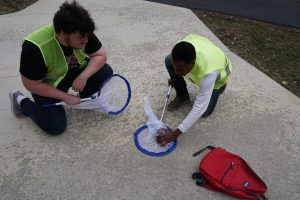With funding from the Columbus Zoo Conservation Fund, Ohio Wildlife Center has launched Lights Out Columbus this spring to save Neotropical migratory birds from disorienting city lights during spring migration.
This pilot monitoring and collection program started March 15 with volunteers who are monitoring and collecting injured birds seven days a week from targeted streets in downtown Columbus. The spring effort will continue until June 1, when most Neotropical migrants are traveling back north from overwintering grounds.
An emergency triage team of staff and volunteers head out each morning between 5:30 a.m. and 8 a.m. to survey key areas, collect injured birds and rush them back to the Wildlife Hospital for treatment and care. The hospital is now equipped with a special holding area for these special patients. Admitted birds receive a thorough exam, supportive care, nutrition and a quiet place to recuperate.
Many will recover within 24 hours, ready to continue their journey, sometimes traveling thousands of miles from where they started. Their caloric requirements are extremely high, so the hospital provides high-quality diets, specific to each species for these feathered travelers.
Each spring and fall, millions of birds migrate through Ohio as they travel between their breeding and overwintering grounds. Lights or reflective glass on tall buildings can disorient birds and draw them into buildings. This causes many birds to strike windows or circle buildings until they fall from exhaustion, according to Stormy Gibson, director of education at Ohio Wildlife Center.
Collisions with buildings are a leading cause of bird fatality and up to half a billion birds are estimated to die each year in North America from building collisions, she noted.
 In addition to monitoring and rescue efforts with regional partners, 29 buildings in urban Columbus are participating in Lights Out Columbus by reducing their light emissions at night. These conservation-minded county and corporate partners are helping take direct action to minimize bird strikes, Gibson noted. She also works closely with Ohio Lights Out Project Coordinator Matt Shumar, who is based in Cleveland.
In addition to monitoring and rescue efforts with regional partners, 29 buildings in urban Columbus are participating in Lights Out Columbus by reducing their light emissions at night. These conservation-minded county and corporate partners are helping take direct action to minimize bird strikes, Gibson noted. She also works closely with Ohio Lights Out Project Coordinator Matt Shumar, who is based in Cleveland.
“The Lights Out Columbus project is an innovative approach to bird conservation, as it could significantly reduce bird collision deaths, as well as assist building owners and managers to decrease their energy costs,” Gibson said.
Data collection is also a main focus area of the volunteers during their downtown early morning rescue efforts. They have been trained in data collection and species identification and will record information about collisions, locations, injuries and emerging patterns about what structures are causing the highest number of bird injuries, Gibson said.
“Lights Out project outcomes will be vital to our understanding of increasing threats to migratory songbirds,” Gibson said. “Our Wildlife Hospital has extensive experience in treating songbirds, and we cared for more than 2,500 birds in the past year,” she said.
“This is a key conservation initiative we are directing with partnerships across the region of businesses, environmental groups, local government and universities,” she added. “Education across the community about how individuals can help decrease hazards to migratory birds is the main component of this effort.”
“Awareness building will truly engage all stakeholders to make changes in our urban environment that will have a significant impact to save songbirds,” she added.
Volunteers are still welcome to join the project and may contact the volunteer coordinator, Kate Tullos, at educationsupport@ohiowildlifecenter.org or call 614-407-7833. Information is also available at www.ohiowildlifecenter.org and https://ohiolightsout.org/
Additional background can be found here: https://www.audubon.org/conservation/project/lights-out